Among leather products, cordovan is often touted as being one of the best, especially when it comes to footwear, so you might be wondering: what makes this type of leather so special that it can command upwards of $500 per pair of shoes?
Even at first blush, cordovan does look a bit different than other types of leather. It’s particularly smooth and lustrous and it possesses a rich color. But, is this reason enough for cordovan to demand such high prices, or does it also possess other unique traits that set it apart from the standard cowhide? Let’s define what the leather is where it originates from, and its pros and cons, to get answers.
What is Cordovan Leather?
Cordovan leather, or “shell cordovan” as it’s also sometimes known, is a leather that’s derived from the hindquarters of horsehide. The term “shell” refers to the specific part of the hide once it has been split horizontally to remove the grain, and the term “cordovan” derives from the Spanish city of Córdoba, meaning “from Córdoba.”
Unlike other leather, which is typically the outer hide of the animal, cordovan comes specifically from a membrane located in between two epidermis layers in the rear quarters of horse’s a**.


And, as is the case with other natural leather products, the exact usable size comes from the overall dimensions of the skin. So, that’s what cordovan leather is, but we still haven’t really explained why it’s so expensive as, after all, it still seems mostly similar to other types of leather so far.
History of Cordovan Leather
We’ll next attempt to find further answers by taking a look at the history of cordovan leather.
Leather, in general, has been produced and used since around 2200 BC, but the first documented use of horse leather comes from 7th-century Spain – first by the Visigoths and later by the Moors. By the 16th and 17th centuries, skilled craftsmen were creating ornately decorated horse leather goods, such as wall hangings, trunks, shields, and armor, and the Spanish city of Córdoba has remained a highly-reputed area for leather tanning ever since.
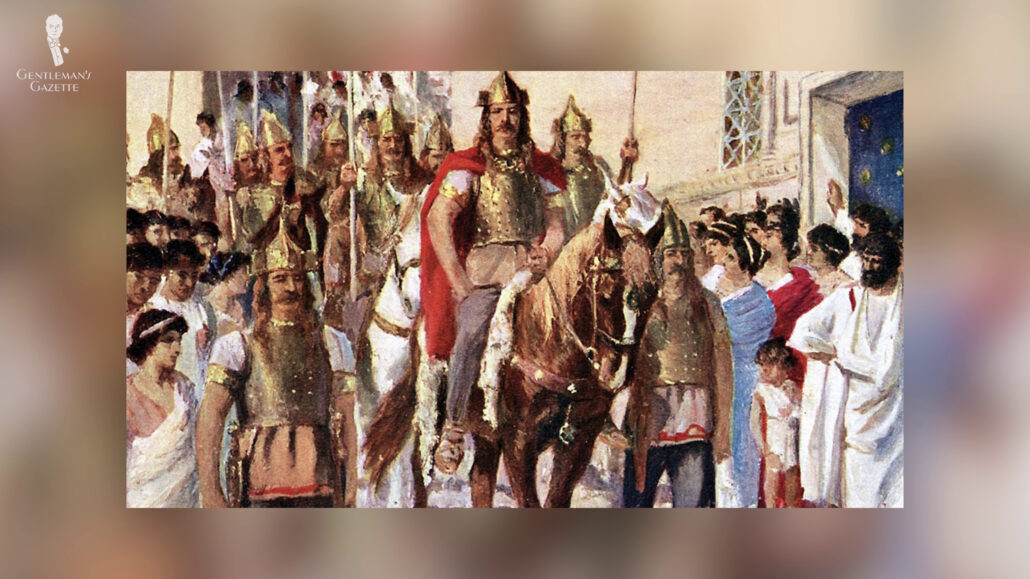
Even today, you can find artisans in Córdoba who maintain these traditions such as Meryan, located in the heart of the city.
Because of its qualities, beauty, and durability, cordovan leather was sought after by Spanish royalty and, even before the age of Instagram, this was influencing other royal families to buy it as well. However, it wasn’t until the 19th century that cordovan leather was specifically connected to the type of tanned horsehide that’s used today.
In the mid-1800s, German and Dutch tanners arrived in the US with their spiegelware, which translates to “mirror wear.” This name is in reference to the fact that, once it’s polished, cordovan leather can attain a shiny mirror-like quality. These tanners, by the way, became known as “cordwainers.”
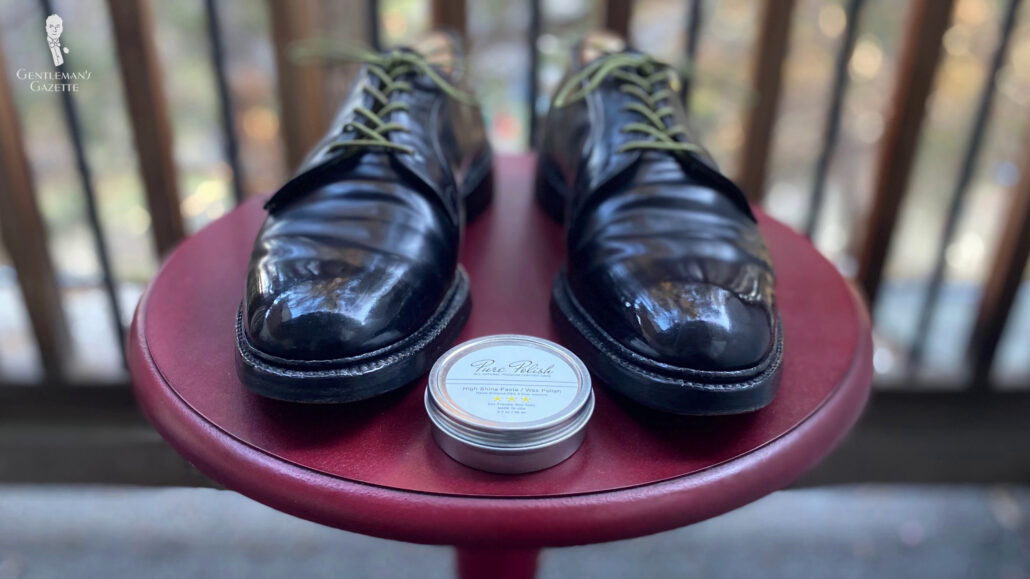
Despite its glossy surface, though, at this point in history, cordovan was still more prized for its durability than for its good looks. For instance, it was commonly used as the main component in razor strops, where a cutthroat razor would be run back and forth across the leather surface to hone its edge. There was high demand for these strops until around the time of the First World War when the safety razor became the default shaving method for most men, replacing the straight razor.
So, then, in their search for alternative uses for cordovan leather, American tanners perfected their tanning techniques and made the leather softer and more suitable for footwear. Looking at this early-20th century ad from Wolverine, we can see that they were advertising their shell cordovan work boots and gloves as being buckskin soft and they included a free pen, too.
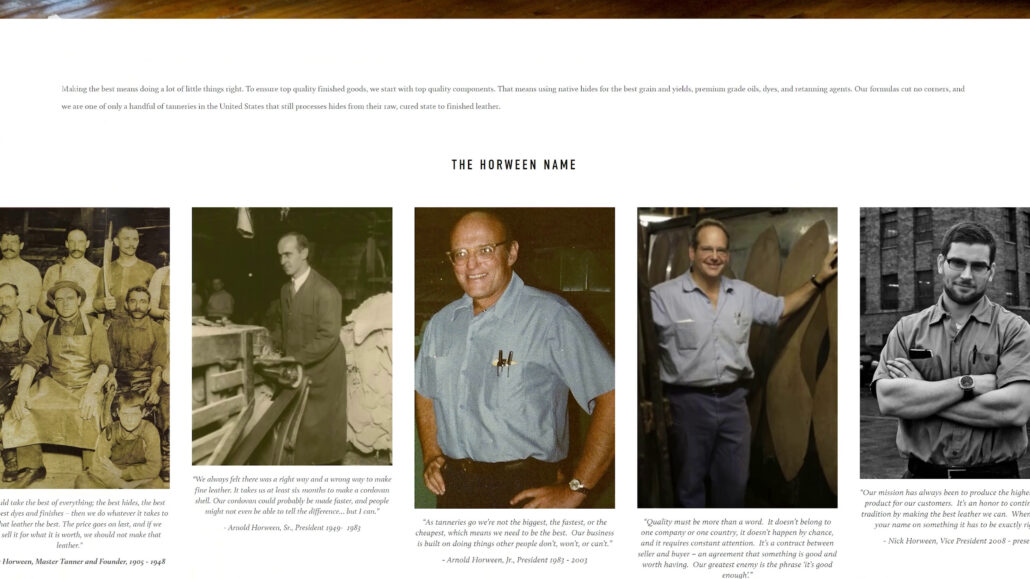
However, if we back up a bit to the year 1905, we’ll see the formation of one of the most closely associated names with shell cordovan – that of Horween based in Chicago. Since its founding year, Horween has remained a family business and at present, five generations of the Horween family have contributed to the company’s legacy.
In 1929, the company began providing leather to Rawlings, who manufacture major league baseball gloves; and not only are NFL and CFL footballs made from Horween leather, but so too are NBA basketballs.
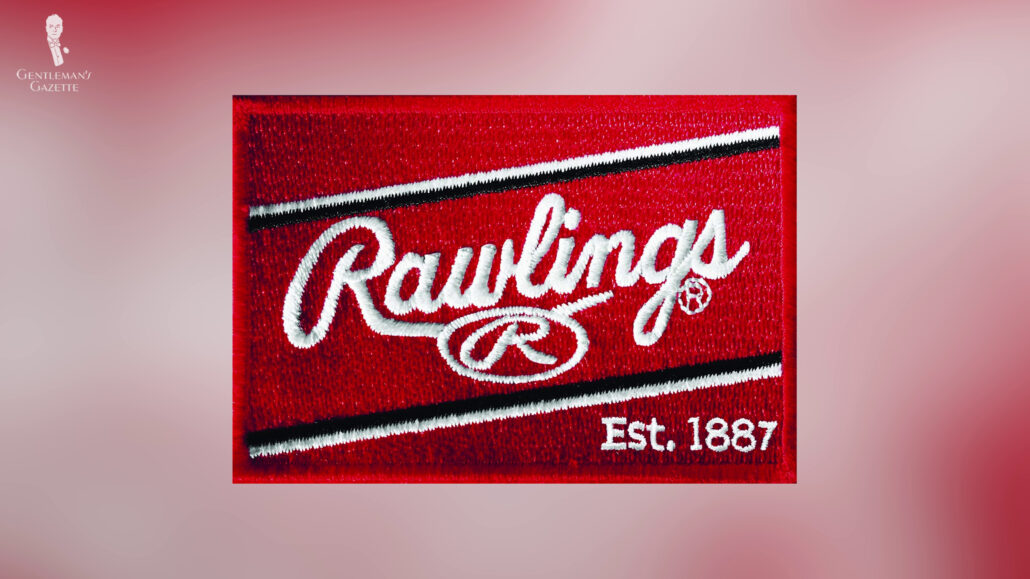
So, we can definitely see that Horween are good sports, but the manufacturer of sporting equipment only makes up around 40% of their business, with the other 60% going towards shoes, clothing, and accessories.
Alden, a well-known name in the world of quality shoemaking, has been Horween’s largest customer for cordovan leather since 1930. Of course, other well-known brands also include cordovan leather from Horween in their products such as Brooks Brothers, Cole Haan, Johnston & Murphy, and Allen Edmonds.
Horween Leather Company Chicago
How is Cordovan Leather Made?
Now that we know more about cordovan leather’s history, let’s take a look at specifically how it’s made and manufactured. The tanning of cordovan leather is very complex and labor-intensive as over six months and more than a hundred processes are involved for each piece.
Tanning is a process that does two basic things: first, it stops the natural process of decomposition; and second, it brings out the desired characteristics in the finished leather.
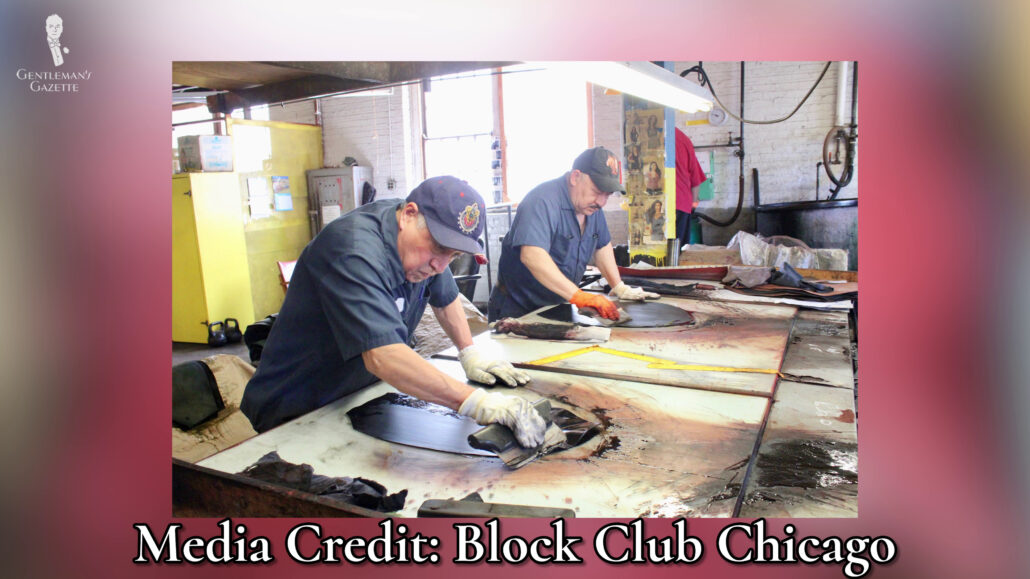
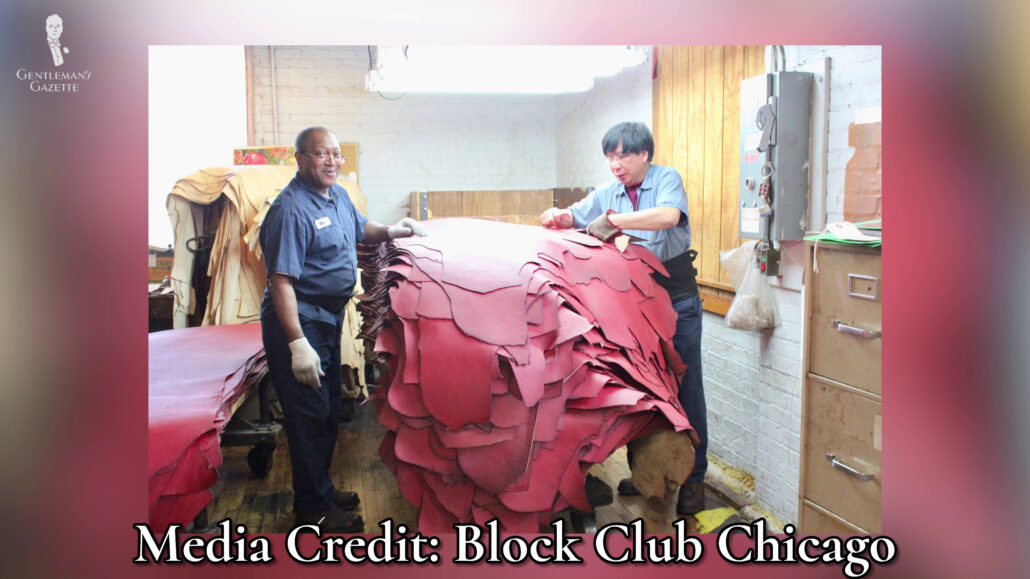
The tanning process starts out with salted horse hides. The salt is used as it preserves the hides during transport. The hides are then cut down by hand, selecting only the, well, butt portions for the tanning process.
Next, the hair is removed using a chemical process before the hides are pickled for 24 hours. This process effectively draws out any unwanted elements preparing the hides for tanning. Once the fats and proteins have been removed from the hides, they’re tanned in large pits.
The tanning solution typically consists of chestnut and quebracho tree bark, as well as some resins. This particular type of tanning is known as vegetable tanning because it uses tannins extracted from natural vegetative sources.
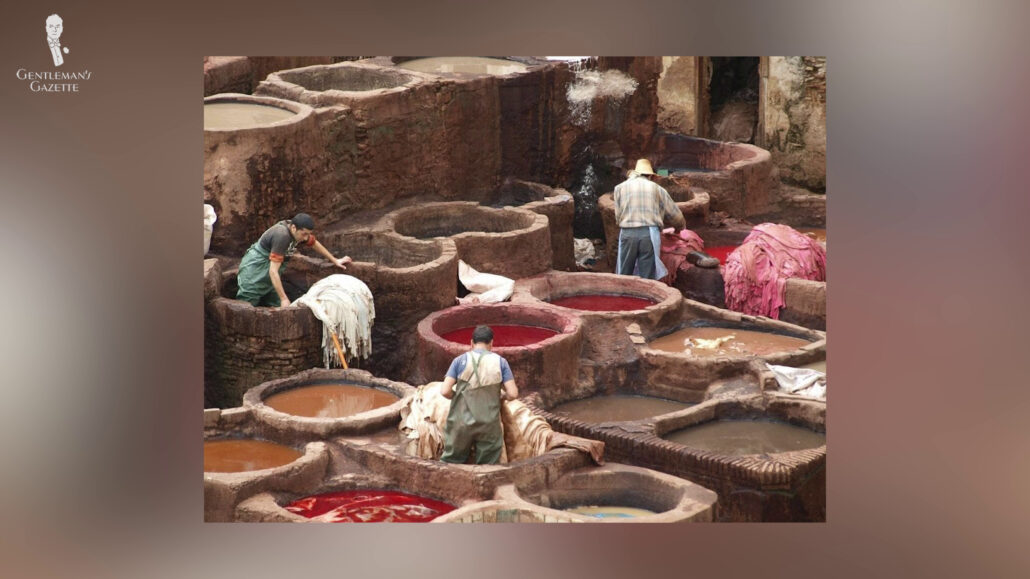
During tanning, the hides are affixed into frames that are agitated constantly so that the tannins don’t settle in any one place and the hides are evenly tanned. After 30 days, the hides are taken out of the tanning solution and then shaved down to expose the shell membrane.
The tanning process then begins again with the hides being put into another pit containing an even stronger tanning solution. And this goes on for another 30 days.
These two tanning stages can’t be rushed as it does take time for the tannins to penetrate the full thickness of the hides. And even after they’ve spent a full 60 days in the tanning pits, the hides still aren’t ready to be sold as they have to go through another four months of work. The hides will be colored and polished several times by hand with pressing and resting periods in between.
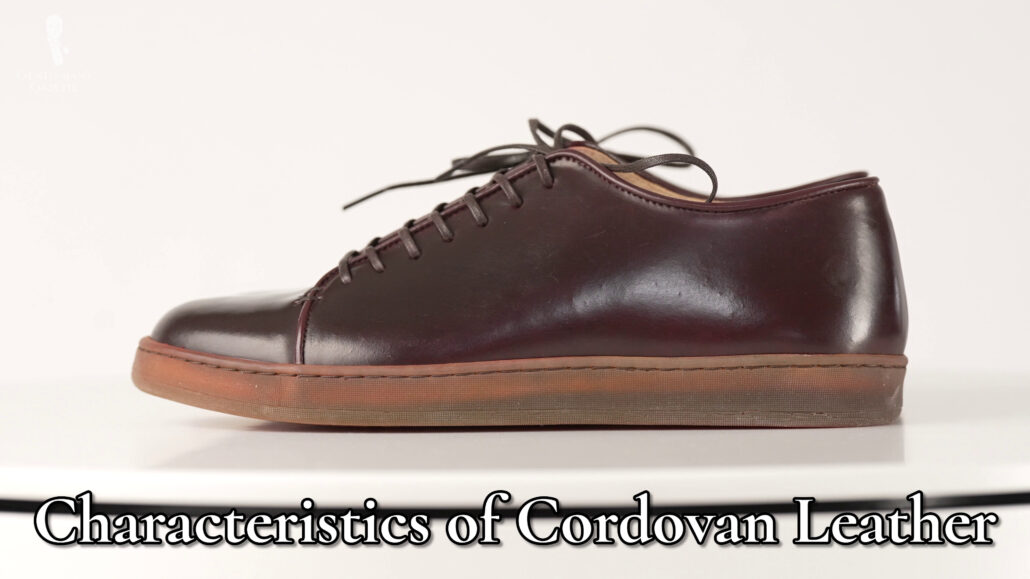
Finally, then, after half a year of work, these hides are finally ready to be sold to manufacturers. It’s at this point that we can finally start to see the signature characteristics of shell cordovan coming through in the finished hides.
Characteristics of Cordovan Leather
1. Its Shine
That particularly glossy shiny surface, for instance, isn’t just due to the repeated pressing and polishing the hides received during their manufacturing process. It’s also due to the poor structure of the leather itself as the pores of cordovan leather are much smaller and more densely packed. If we compare cordovan to calf leather, you can see the difference almost immediately. Where the calf skin has a slightly textured appearance, the cordovan leather looks fully smooth and slick.
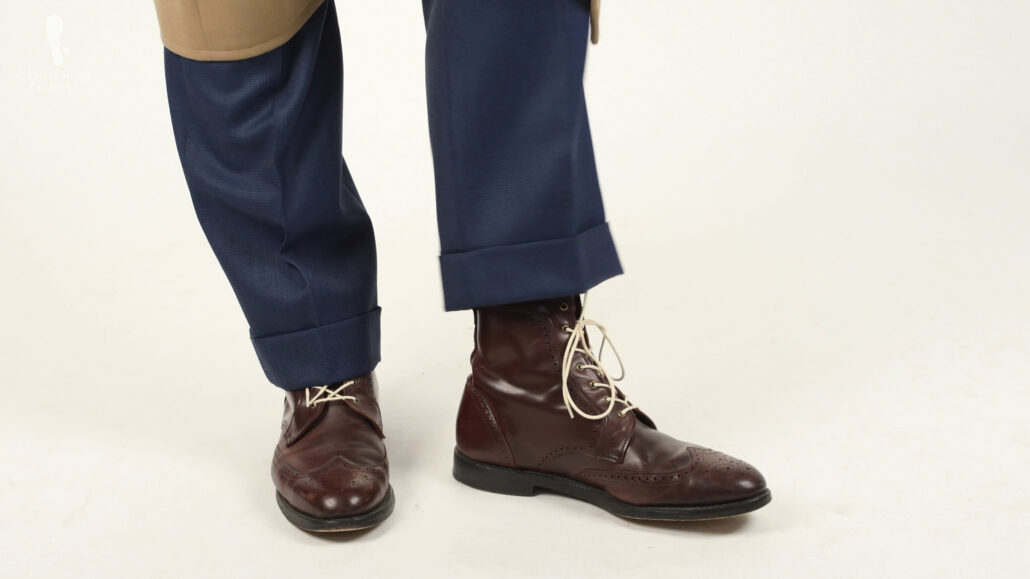
Indeed, when you’re polishing a pair of calfskin shoes, multiple layers of polish are required to create that shiny mirror finish. Each round of polish gradually continues to fill up these more open pores of the calfskin, creating a more flattened overall surface and a shinier look. But, because of the tiny size of its pores, cordovan leather is naturally smoother, to begin with, and thus, it requires less work to maintain that shiny finish. But, the shine isn’t the only benefit of cordovan leather.
2. Durability and Water Resistance
As we already know from our historical overview, it was once the leather of choice if you needed something hard-wearing and durable. Its association with work boots that are both rugged and stylish is almost legendary at this point and, indeed, Wolverine is still producing boots that echo this heritage even if they have stopped the free pen promotion. And while technological advancements might mean that you are less likely to find a pair of cordovan work boots on a job site today, this doesn’t make the leather itself any less durable.
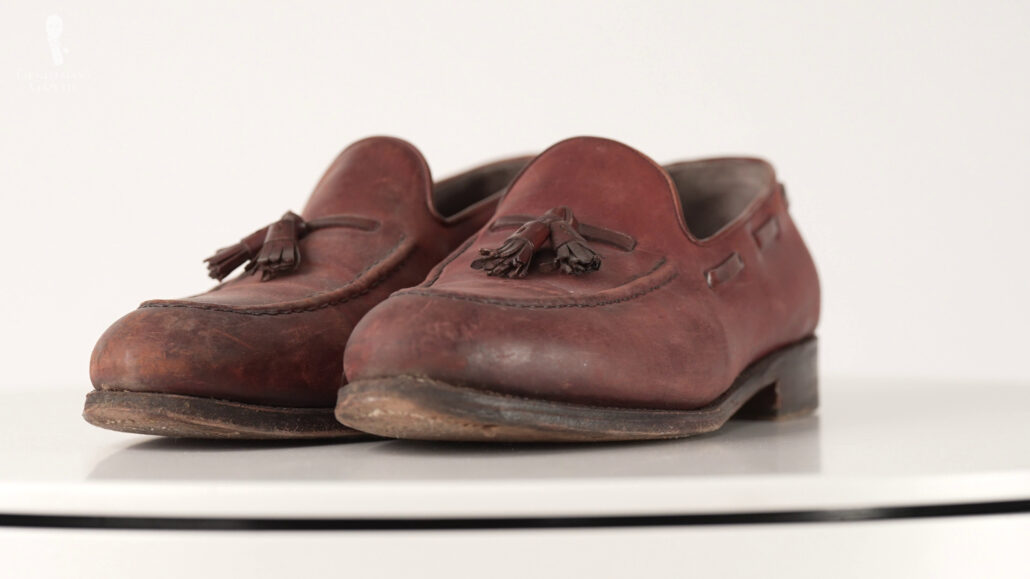
After their extensive tanning processes, cordovan leathers are naturally resistant to water. The key word there though is “resistant” as no leather is actually completely waterproof, unless you apply a waterproofing treatment to it. Naturally speaking though, cordovan leather does come the closest to being waterproof here and it can withstand quite a bit of water.
Not only that but cordovan is also generally much tougher than calfskin, and you’ll find it’s more difficult to scratch or tear cordovan leather than most typical calfskin offerings.
3. No Cracks
If you’ve ever owned even a single pair of leather shoes, you’re bound to have experienced some creasing. Leather is a skin, of course, and it needs to be able to move with your body as you wear it. Shoes that didn’t flex at all would be kind of redundant after all. The problem with creasing in leather, though, is it can eventually lead to cracking.
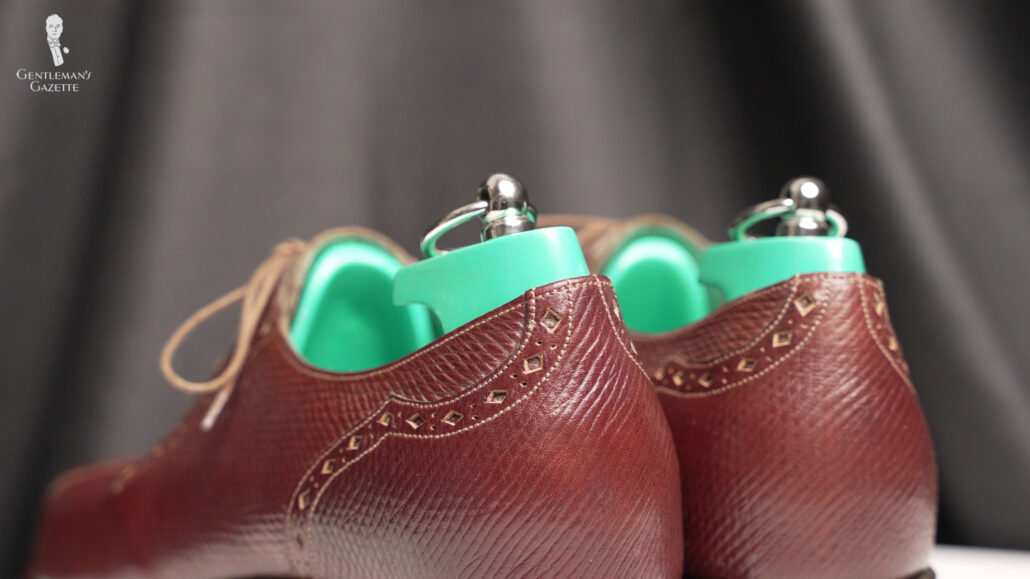
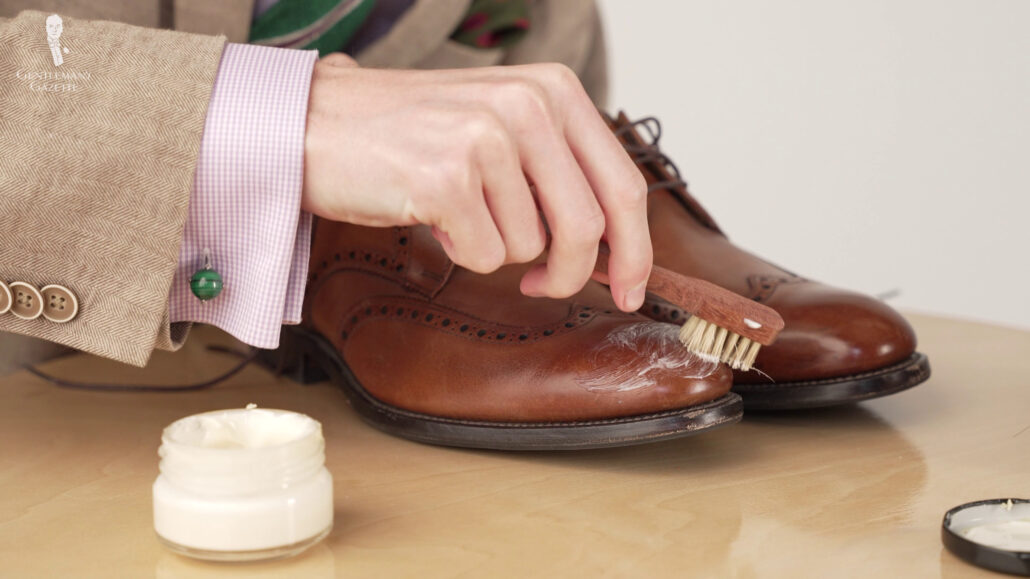
A crease in a pair of calfskin shoes is actually formed from many miniature hairline creases in areas of high flexion, such as across the vamp of the shoe. This process is natural and, in fact, completely inevitable, and it can be combated with a good pair of shoe trees and by nourishing the leather of your shoes with cream polishes. But, if the leather isn’t hydrated and the creases are allowed to develop. They will eventually form full-blown cracks.
This, by the way, is a problem that is ugly when covered poorly or not at all, expensive when covered well, and actually impossible to fix completely. Unlike the creases that form in calfskin though, cordovan leather develops ripples over time.
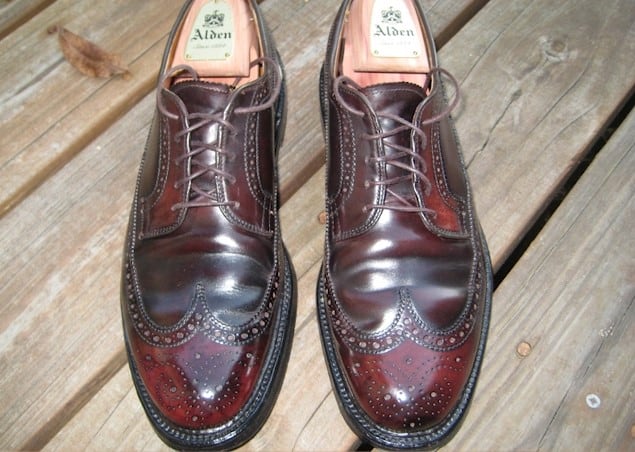
As you can see, then, even a well-used pair of cordovan shoes rarely contains many or any creases. This means that the leather is much less likely to crack and, therefore, that the lifespan of a pair of cordovan shoes is going to be longer on average than that of a pair of calfskin shoes.
4. Distinctive Tones
Because of the unique tones provided by the natural tannins as part of the tanning process. Cordovan leather ages very well and develops a beautiful patina over time. Unlike other types of hides, the leather itself doesn’t actually accept colored dyes very well, so you’re most often going to see cordovan leather in shades of brown as these are easiest to achieve through the natural tanning process.
Of course, darker colors are also available and pretty much anything can be dyed all the way to black. But, cordovan is perhaps most well known for a unique color – also itself called “cordovan” – which is a deep, almost rosy shade of burgundy.

Over time, this particular cordovan color ages from being a burgundy brown to exposing more of its red undertones. Eventually, it will even develop lustrous highlights that are almost reminiscent of cherries.
Because cordovan can also refer to this particular color as well as to the leather itself, other leathers can be produced in a cordovan color – somewhat confusingly. So, be sure to pay attention when you’re shopping to see if cordovan refers just to the color or to the actual leather itself.
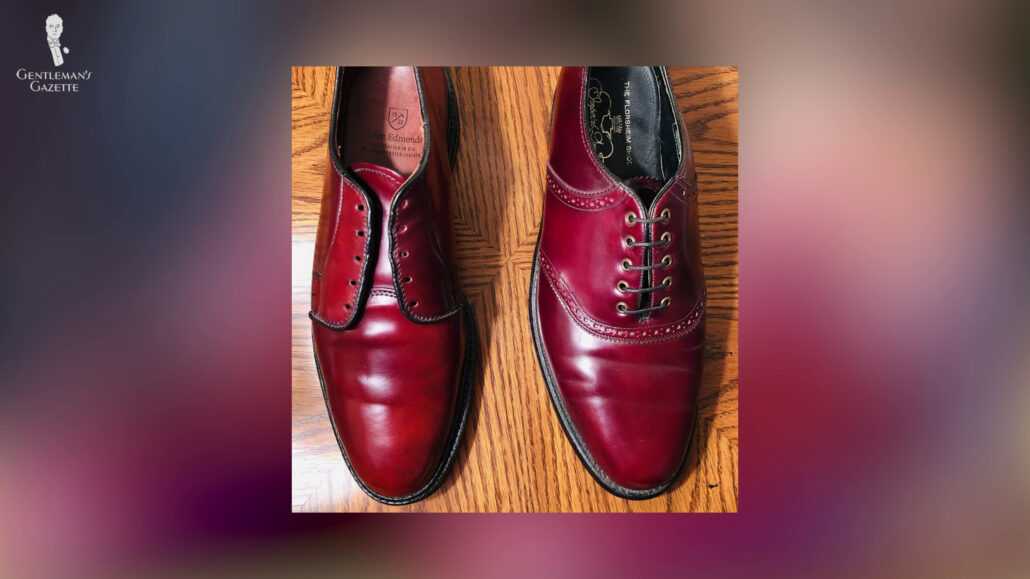
Drawbacks of Cordovan Leather
There are some clear differences between shell cordovan and most other leather types – in particular, calfskin, which we’ve been comparing it to most because calf is the most commonly used type of leather for most leather goods. But, as much as cordovan leather has clear upsides, it isn’t a miracle material and it does also have a few drawbacks as well.
1. Long Break-in Period
It’s only natural that choosing a tougher material means that you’re going to have a tougher time breaking it in and, while we’re not sure if Wolverine’s early work boots actually were buckskin soft, we do have first-hand experience with some modern-day cordovan leather goods and we can say that it can be a bit of a pain to break in both figuratively as well as literally.
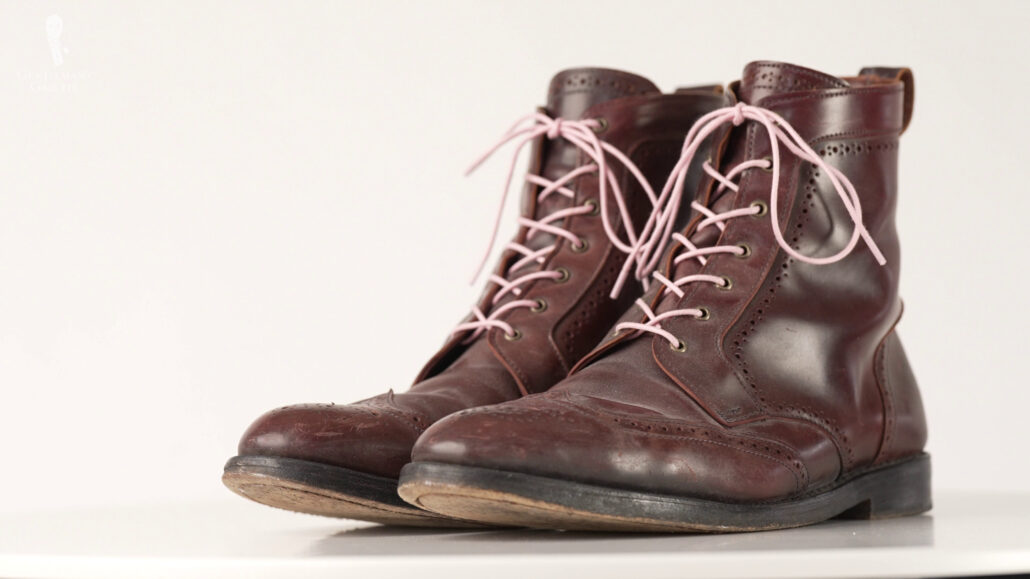
Of course, this depends entirely on the volume and application of the leather goods as a cordovan leather watch band, for instance, will give you a much smaller break-in time. But, as cordovan is most often used for footwear, this is certainly an area where you’re going to feel the pinch in terms of a longer break-in period.
You’ll also find that, due to its tighter pore structure, cordovan leather isn’t as breathable as some other options and we suppose this stands to reason; after all, if it’s good at keeping water out, it’s probably also good at keeping moisture in. And while everyone’s feet are going to change slightly due to the temperature, cordovan leather may be a tougher choice for you if your feet are frequently hot and they’re not going to feel very comfortable in some pairs of cordovan shoes.
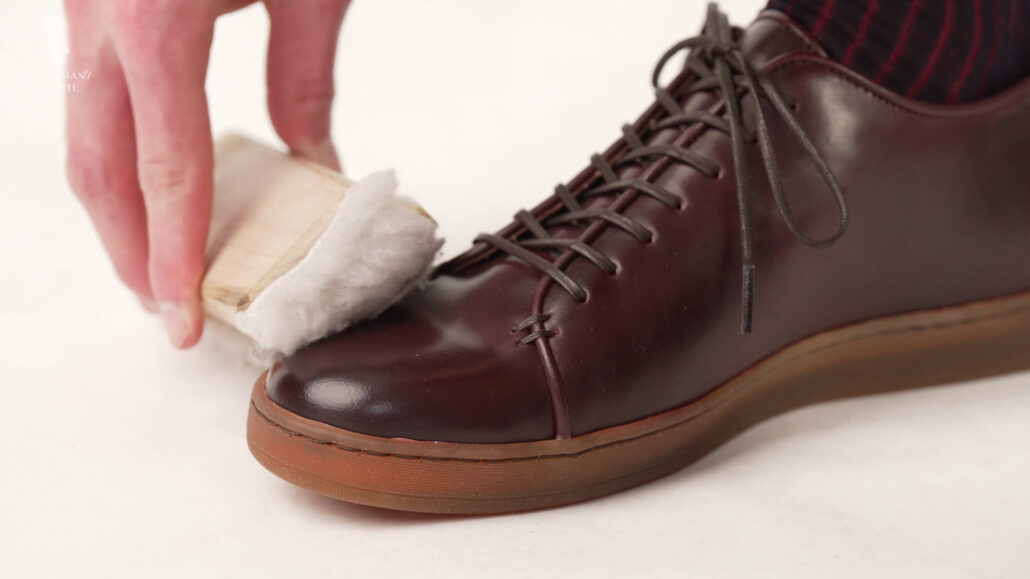
2. Challenging Upkeep
Another potential drawback is challenging upkeep. Most people are going to know that calfskin leather requires a certain kind of maintenance in order to preserve its look, but cordovan requires a different mindset when it comes to shoe care.
Regular shoe polish typically contains a fair amount of solvents in order to bring out the luster of calfskin. However, these solvents can actually be harmful to the structure of cordovan leather if they’re used excessively
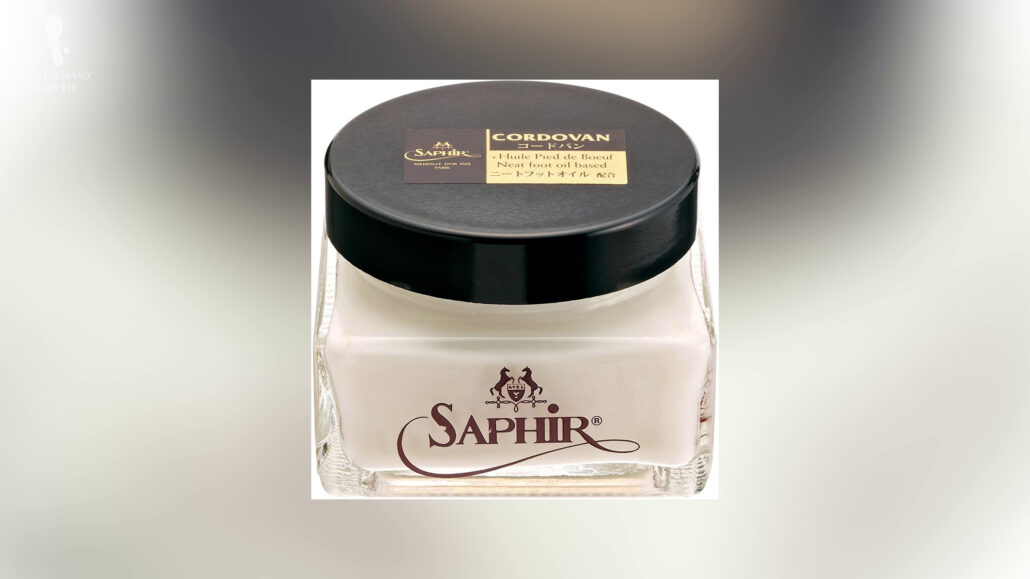
Ideally, then, you’ll want to look for specific cordovan care items that possess oils instead of solvents to nourish the cordovan leather. Noted polish manufacturer Saphir has a dedicated polish for cordovan leather, for example.
And, of course, you’ll want to consider another specific product for cordovan care – the deer polishing bone. Yes, this is actually a bone from a deer that retains oils in order to both lubricate as you pass over the cordovan surface as well as to reintroduce the oils back into the leather more efficiently. The bone itself is also used to help preserve the shape of the cordovan by pressing down and smoothing out any ripples that may be forming. Naturally, though, this process is completely unique to cordovan leather and it may therefore be a detractor if you don’t want to purchase a completely separate set of leather care products just for your cordovan.
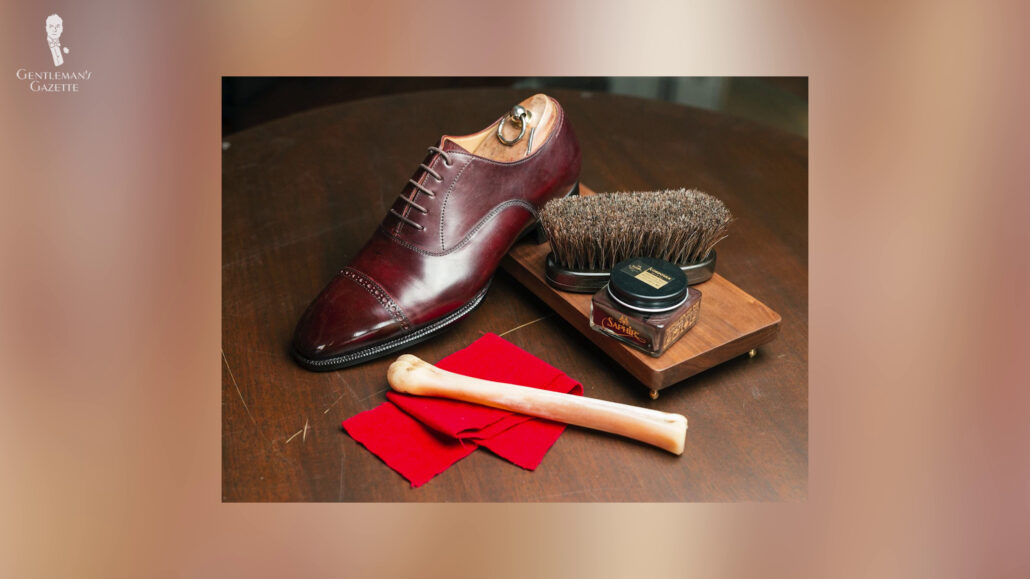
To share a bit of hands-on experience from Raphael, though, as he does own multiple pairs of cordovan footwear, normal or calf leather polishing products can be used on cordovan. Just make sure that the concentration of solvents is low, that you don’t overapply, and that you don’t use wax polishes. The bone may be the ideal tool for the job but, if you just want to stick with standard polishing creams and brushes, you can do so; just use them sparingly.
3. Lack of Versatility
As our final drawback here, despite its naturally shiny appearance, cordovan leather doesn’t always translate well to more formal dress shoe styles.
It might have to do with the history of cordovan as work wear or it might have to do with the fact that it ripples over time, but it can be more difficult to create an elegant pair of whole-cut Oxfords for example or at least a pair that stays elegant from cordovan leather. Therefore, you’re going to be far more likely to see cordovan in shoe styles that fit more into the smart casual mold like long-winged brogues, loafers, and, of course, boots.
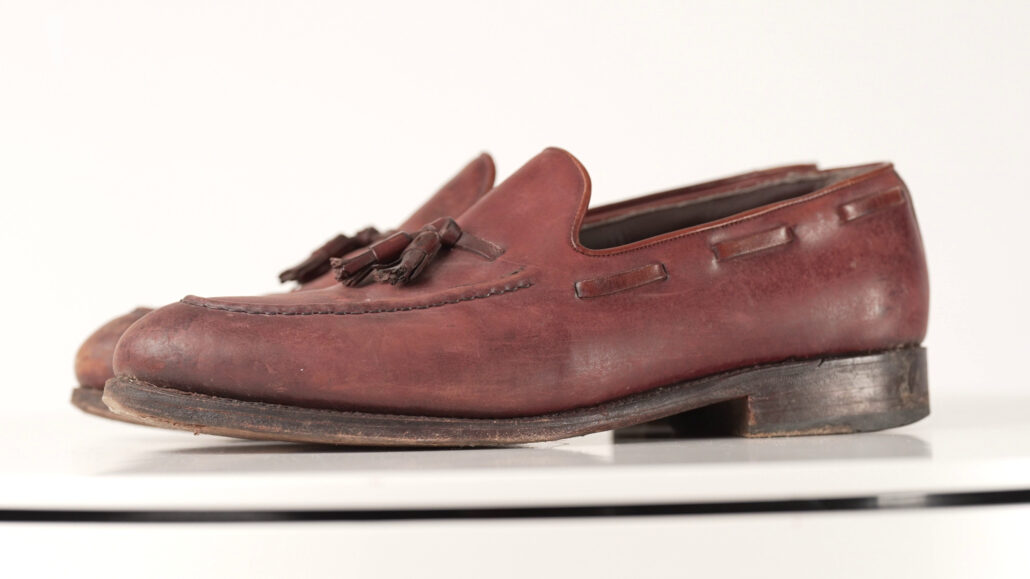
On the other hand though, in today’s 21st-century world, styles like these are going to be comparatively more dressy than the flip flops and sneakers that abound. In fact, some artisanal manufacturers – like Crown Northampton in England – are even making sneaker styles from cordovan leather, showing that cordovan and casual wear can pair together quite nicely.
Why is Cordovan Leather so Expensive?
Overall then, while cordovan does have many great properties, keep in mind that it isn’t a one-size-fits-all solution for every pair of shoes in your closet. Having looked at all of these different facets of cordovan leather then, we come back to the main question today: just why is it so expensive?
In a nutshell, then, the high price of cordovan comes down mainly to the low overall supply and high overall demand for horse hides as well as the long and complex tanning process that we discussed earlier.
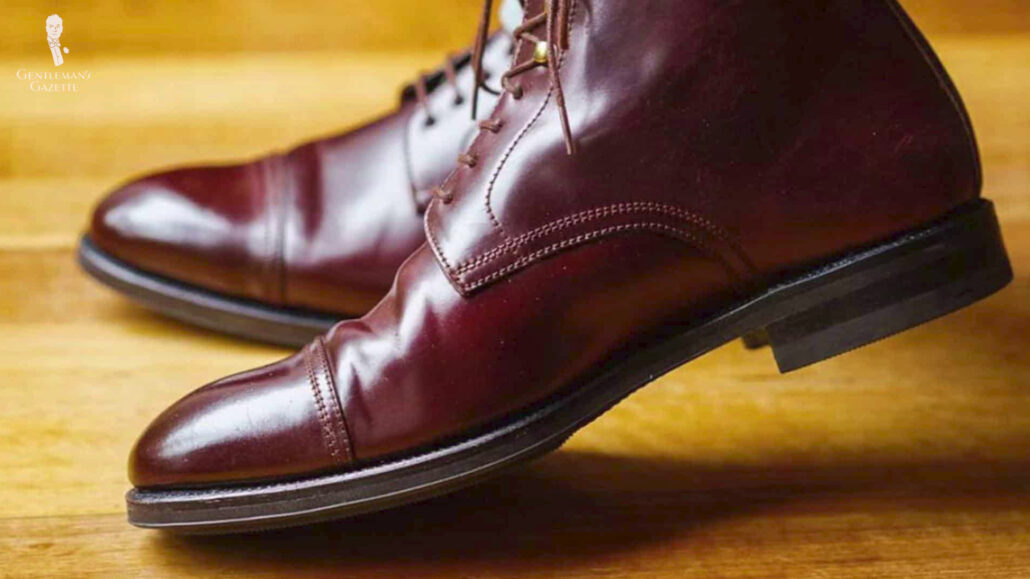
Unlike cattle, horses are only raised as part of the food chain in a few select places around the world; meaning that the overall supply of horse hides is small and not likely to grow anytime soon. Therefore, there’s an inherent scarcity of cordovan leather, which naturally increases the price.
As we’ve already discussed earlier, the tanning process takes six months and a great deal of handwork, and, indeed, there are a small and diminishing number of skilled tanners who are even able to do this work well in the first place.
Given this labor-intensive process then, you’re also paying for the many years of skill and expertise that go into every pair of cordovan shoes and other cordovan products. And not only are the number of horse hides relatively small, but even within them, only a small portion of the horse hide is even able to be used for shell cordovan.
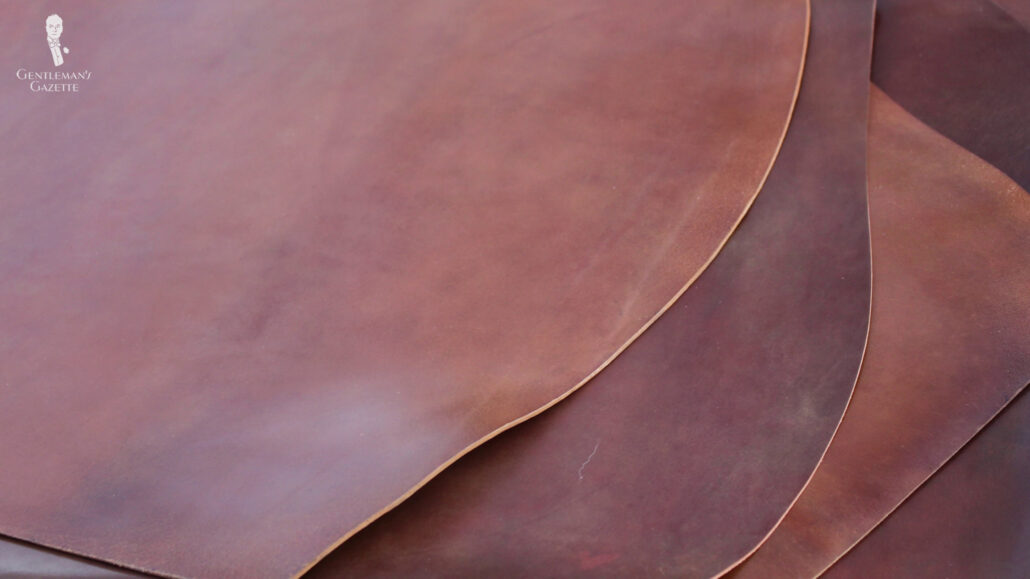
Prices vary, of course, but the typical price for cordovan leather is around $100 per square foot. The small size of the finished shell cordovan hides means that one-and-a-half to two hides are required for even a single pair of shoes. In contrast, one calfskin hide can make as many as three to four pairs of shoes. This then is one of the biggest factors for cordovan’s high price tag.
Conclusion
Overall, then, cordovan leather is a truly unique, intriguing material with a luster that goes far deeper than just its natural shine. Even with its lofty asking price, cordovan leather that’s maintained well is going to be able to stand up to years of wear and should be a joy to behold each time you wear it.
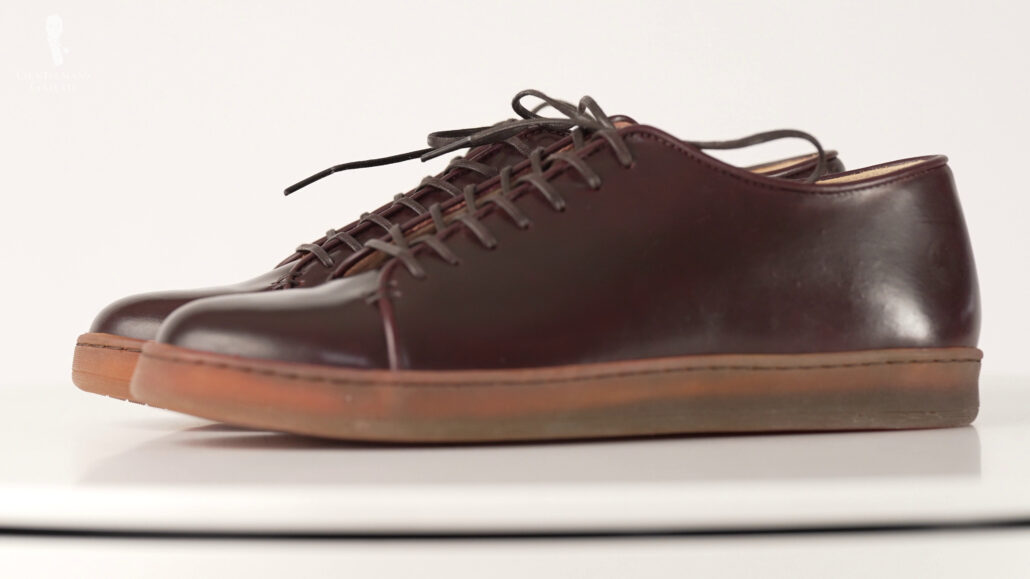
If you own any cordovan products, be sure to let us know what you think of them in the comments below!
Outfit Rundown
Today, I am wearing a pair of tennis shoes in cordovan leather from Crown Northampton. These shoes were sent to us, but this post is completely unsponsored.
The cordovan leather comes from Horween and it’s in their signature #8 color, which is a burgundy shade. As I was able to select the details of these shoes myself, to go along with this burgundy color and to provide a subtle feel, I chose a natural gum sole in a reddish-brown color.
And to go along with these sneakers, I’ve chosen a smart casual outfit that is characterized by soft colors and fabrics. My corduroy trousers are from Cordings in a British tan color.
My cardigan sweater features tones of blue and gray, and my shirt from Charles Tyrwhitt features a checked pattern in burgundy blue and other gray tones.
Rounding out the outfit today are my Fort Belvedere socks; their two-tone shadow striped models in midnight blue and burgundy to harmonize with other colors elsewhere in my outfit.
To go along with the casual feel of today’s outfit, I’ve also elected not to put any product in my hair and to go unshaven as well.
And, of course, you can find the socks I’m wearing here, along with a wide array of other classic men’s accessories, by visiting the Fort Belvedere shop.


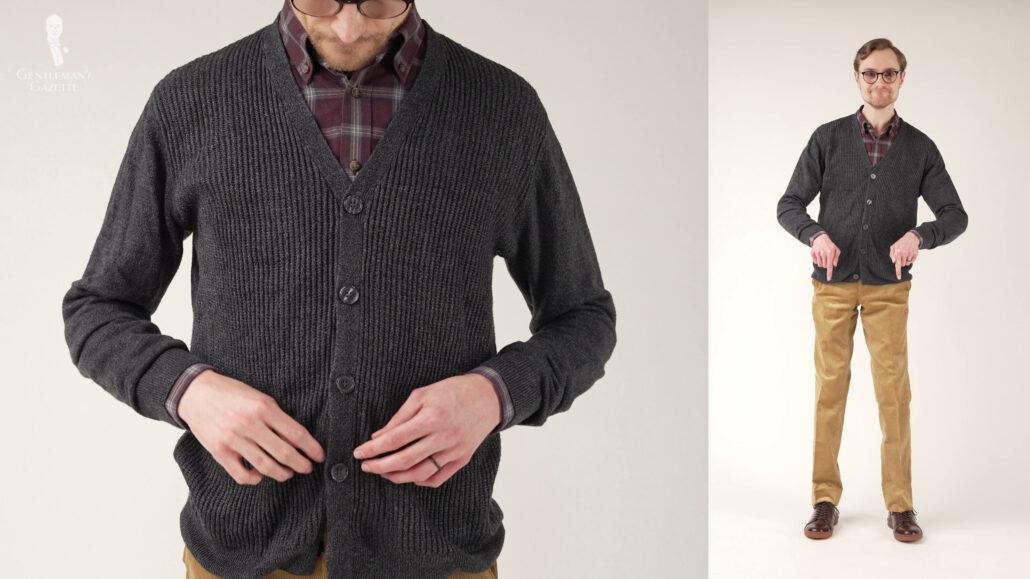
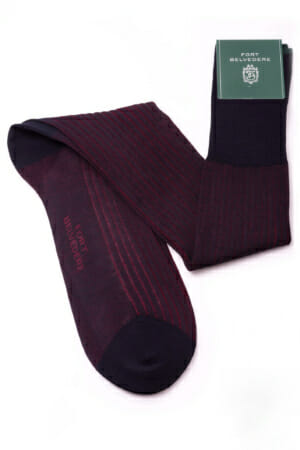
This is the clearest most sensible analysis of this type of leather…and why it takes an enormous amount of time to break them in. Sometimes I think it’s hardly worth the effort and pain. For example, I have a black pair of Allan Edmonds loafers that simply took so long to feel I could wear them all day, they needed every DYI method to break them in; lastly I have a less expensive pair of Sebago loafers that still won’t give in to comfort and joy. Thanks for the post.
Thanks for your support, Kim. With the issues you’ve had with Cordovan, what’s your preferred leather for footwear?
Back in the 60s this type of leather was cheap. I as a child did not know it was horse leather.I believe in maintaining animal rights but natural causes, and the like yes, material from a horse could be salvaged. they were very nice shoes.
Many years ago I ordered a pair of cordovan monk strap shoes from Alden. They are excellent shoes, and are still beautiful. However, I was appalled to learn after some time that they are horse leather – I worked with horses for years, and still ride, and would never have ordered any product made from horses. Very provincial, I know and yes, I still wear them.
I have over a dozen pairs of cordovan in my collection.
Cordovan is a great material. True, it doesn’t present quote as sleek as a fine calf skin from Edward Green or Gaziano & Girling but there are some iut there that pair well with a suit when going a bit less than banker formal. I have a pair of Carmina coridovan double monks that go well with suits but admittedly, most of my Cordovan is for more casual use. My Alden Cordovan George boots have been through all types of nasty weather and are still going strong 15 years and numerous resoles later. Same with the Allen Edmonds cordovan tassel loafers I always pack for travel.
Cordovan suits brogues pretty well. Boots or shoes, cordovan brogues tweak the rustic outfits
Rain spots are a real pain in the rear to brush out. Happily not all my shell is prone to the issue. I think it gets better with wear.
I rarely use products on cordovan versus wiping them down and hitting them with a stiff horse hair brush for a good 10-15 minutes. The deer bone I only use for the deep scratches and that comes with mixed results (same with using the spoon method. One of the reasons I don’t care for too much on the way of polishes/renovateurs/etc is that some have the possibility to change the shoe color a bit. A cobbler I actually trust with my shoe collection gave me a specialty cordovan cream and sure enough I now have 2 different shades of cigar shell shoes.
Another nice thing about cordovan in #8 is that the color can pair with just about everything but black.
Most of my Cordovan shoes are from the “mid range” brands such as Alden, Carmina, and Crockett & Jones though I have a couple from Cleverly as well (the Cleverly’s don’t see hard use). On the other hand, most of my calf collection is from higher end makers such as Edward Green, G&G. And which I will be wearing depends on numerous factors. If I’m going out in the rain, skeet, and snow, I’m most likely taking cordovan. If I’m heading for a night out on the city it’s most likely calf. But happily I have a large enough collection that I can play around a bit.
I wasn’t around in the 60s but still wonder. Regular horse leather has always been on the cheaper side but to my knowledge Shell Cordovan, a special cut of horse leather has always been expensive. Are you sure you remember shell cordovan as being cheap or perhaos you’ve mistaken it for regular horse leather?
Your Whole Cut brief example says it all……….
Preston, as always so well presented.
The beard looks great! You have “The Jaw” for it.
Best/JL